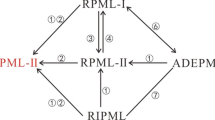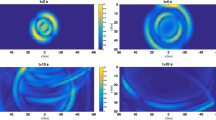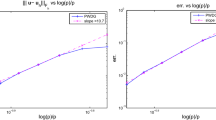Abstract
In this article, several discontinuous Petrov–Galerkin (DPG) methods with perfectly matched layers (PMLs) are derived along with their quasi-optimal graph test norms. Ultimately, two different complex coordinate stretching strategies are considered in these derivations. Unlike with classical formulations used by Bubnov–Galerkin methods, with so-called ultraweak variational formulations, these two strategies in fact deliver different formulations in the PML region. One of the strategies, which is argued to be more physically natural, is employed for numerically solving two- and three-dimensional time-harmonic acoustic, elastic, and electromagnetic wave propagation problems, defined in unbounded domains. Through these numerical experiments, efficacy of the new DPG methods with PMLs is verified.







Similar content being viewed by others
References
Moiola A, Spence EA (2014) Is the Helmholtz equation really sign-indefinite? SIAM Rev 56(2):274–312
Demkowicz L, Gopalakrishnan J (2015) Discontinuous Petrov–Galerkin (DPG) method. ICES report 15–20, The University of Texas at Austin
Zitelli J, Muga I, Demkowicz L, Gopalakrishnan J, Pardo D, Calo VM (2011) A class of discontinuous Petrov–Galerkin methods. Part IV: the optimal test norm and time-harmonic wave propagation in 1D. J Comput Phys 230(7):2406–2432
Petrides S, Demkowicz LF (2017) An adaptive DPG method for high frequency time-harmonic wave propagation problems. Comput Math Appl 74(8):1999–2017
Ernst OG, Gander MJ (2012) Why it is difficult to solve Helmholtz problems with classical iterative methods? In: Graham IG, Hou TY, Lakkis O, Scheichl R (eds) Numerical analysis of multiscale problems, vol 83. Springer, Berlin, pp 325–363
Li X, Xu X (2017) Domain decomposition preconditioners for the discontinuous Petrov–Galerkin method. ESAIM Math Model Numer 51(3):1021–1044
Keith B, Petrides S, Fuentes F, Demkowicz L (2017) Discrete least-squares finite element methods. Comput Methods Appl Mech Eng 327:226–255
Demkowicz L, Gopalakrishnan J (2010) A class of discontinuous Petrov–Galerkin methods. Part I: the transport equation. Comput Methods Appl Mech Eng 199(23–24):1558–1572
Demkowicz L, Gopalakrishnan J, Muga I, Zitelli J (2012) Wavenumber explicit analysis of a DPG method for the multidimensional Helmholtz equation. Comput Methods Appl Mech Eng 213:126–138
Demkowicz L, Li J (2013) Numerical simulations of cloaking problems using a DPG method. Comput Mech 51(5):661–672
Bui-Thanh T, Ghattas O (2014) A PDE-constrained optimization approach to the discontinuous Petrov–Galerkin method with a trust region inexact Newton-CG solver. Comput Methods Appl Mech Eng 278:20–40
Gopalakrishnan J, Muga I, Olivares N (2014) Dispersive and dissipative errors in the DPG method with scaled norms for Helmholtz equation. SIAM J Sci Comput 36(1):A20–A39
Gopalakrishnan J, Schöberl J (2015) Degree and wavenumber [in]dependence of Schwarz preconditioner for the DPG method. In: Kirby R, Berzins M, Hesthaven J (eds) Spectral and high order methods for partial differential equations ICOSAHOM 2014 (Lecture notes in computational science and engineering), vol 106. Springer, pp 257–265 (2015)
Gopalakrishnan J, Sepulveda P (2017) A spacetime DPG method for acoustic waves. ArXiv e-print arXiv:1709.08268 [math.NA]
Carstensen C, Demkowicz L, Gopalakrishnan J (2016) Breaking spaces and forms for the DPG method and applications including Maxwell equations. Comput Math Appl 72(3):494–522
Niemi AH, Bramwell J, Demkowicz L (2011) Discontinuous Petrov–Galerkin method with optimal test functions for thin-body problems in solid mechanics. Comput Methods Appl Mech Eng 200(9–12):1291–1300
Bramwell J, Demkowicz L, Gopalakrishnan J, Weifeng Q (2012) A locking-free \(hp\) DPG method for linear elasticity with symmetric stresses. Numer Math 122(4):671–707
Bramwell, J (2013) A discontinuous Petrov–Galerkin method for seismic tomography problems. Ph.D. thesis, The University of Texas at Austin, Austin, Texas, USA
Gopalakrishnan J, Qiu W (2014) An analysis of the practical DPG method. Math Comput 83(286):537–552
Carstensen C, Demkowicz L, Gopalakrishnan J (2014) A posteriori error control for DPG methods. SIAM J Numer Anal 52(3):1335–1353
Keith B, Fuentes F, Demkowicz L (2016) The DPG methodology applied to different variational formulations of linear elasticity. Comput Methods Appl Mech Eng 309:579–609
Carstensen C, Hellwig F (2016) Low-order discontinuous Petrov–Galerkin finite element methods for linear elasticity. SIAM J Numer Anal 54(6):3388–3410
Fuentes F, Keith B, Demkowicz L, Le Tallec P (2017) Coupled variational formulations of linear elasticity and the DPG methodology. J Comput Phys 348:715–731
Fuentes F, Demkowicz L, Wilder A (2017) Using a DPG method to validate DMA experimental calibration of viscoelastic materials. Comput Methods Appl Mech Eng 325:748–765
Demkowicz L, Gopalakrishnan J, Nagaraj S, Sepulveda P (2017) A spacetime DPG method for the Schrödinger equation. SIAM J Numer Anal 55(4):1740–1759
Bettess P (1977) Infinite elements. Int J Numer Methods Eng 11(1):53–64
Demkowicz L, Shen J (2006) A few new (?) facts about infinite elements. Comput Methods Appl Mech Eng 195(29):3572–3590
Keller JB, Grote MJ (2000) Exact nonreflecting boundary condition for elastic waves. SIAM J Numer Anal 60(3):803–819
Engquist B, Majda A (1977) Absorbing boundary conditions for numerical simulation of waves. Proc Natl Acad Sci USA 74(5):1765–1766
Engquist B, Majda A (1979) Radiation boundary conditions for acoustic and elastic wave calculations. Commun Pure Appl Math 32(3):313–357
Bayliss A, Turkel E (1980) Radiation boundary conditions for wave-like equations. Commun Pure Appl Math 33(6):707–725
Higdon RL (1987) Numerical absorbing boundary conditions for the wave equation. Math Comput 49(179):65–90
Guddati MN, Tassoulas JL (2000) Continued-fraction absorbing boundary conditions for the wave equation. J Comput Acoust 8(01):139–156
Berenger JP (1994) A perfectly matched layer for the absorption of electromagnetic waves. J Comput Phys 114(2):185–200
Chew WC, Weedon WH (1994) A 3D perfectly matched medium from modified Maxwell’s equations with stretched coordinates. Microw Opt Technol Lett 7(13):599–604
Chew WC, Jin JM, Michielssen E (1997) Complex coordinate stretching as a generalized absorbing boundary condition. Microw Opt Technol Lett 15(6):363–369
Bramble J, Pasciak J (2007) Analysis of a finite PML approximation for the three dimensional time-harmonic Maxwell and acoustic scattering problems. Math Comput 76(258):597–614
Collino F, Monk P (1998) The perfectly matched layer in curvilinear coordinates. SIAM J Sci Comput 19(6):2061–2090
Hohage T, Schmidt F, Zschiedrich L (2003) Solving time-harmonic scattering problems based on the pole condition II: convergence of the PML method. SIAM J Numer Anal 35(3):547–560
Lassas M, Somersalo E (1998) On the existence and convergence of the solution of PML equations. Computing 60(3):229–241
Turkel E, Yefet A (1998) Absorbing PML boundary layers for wave-like equations. Appl Numer Math 27(4):533–557
Michler C, Demkowicz L, Kurtz J, Pardo D (2007) Improving the performance of perfectly matched layers by means of \(hp\)-adaptivity. Numer Methods Partial Differ Equ 23(4):832–858
Vaziri Astaneh A, Guddati MN (2016) A two-level domain decomposition method with accurate interface conditions for the Helmholtz problem. Int J Numer Methods Eng 107(1):74–90
Bramble J, Pasciak J, Trenev D (2010) Analysis of a finite PML approximation to the three dimensional elastic wave scattering problem. Math Comput 79(272):2079–2101
Chen Z, Xiang X, Zhang X (2016) Convergence of the PML method for elastic wave scattering problems. Math Comput 85(302):2687–2714
Collino F, Tsogka C (2001) Application of the perfectly matched absorbing layer model to the linear elastodynamic problem in anisotropic heterogeneous media. Geophysics 66(1):294–307
Hastings FD, Schneider JB, Broschat SL (1996) Application of the perfectly matched layer (PML) absorbing boundary condition to elastic wave propagation. J Acoust Soc Am 100(5):3061–3069
Vaziri Astaneh A, Urban MW, Aquino W, Greenleaf JF, Guddati MN (2017) Arterial waveguide model for shear wave elastography: implementation and in vitro validation. Phys Med Biol 62:5473–5494
Vaziri Astaneh A, Guddati MN (2017) Dispersion analysis of composite acousto-elastic waveguides. Compos Part B Eng 130:200–216
Vaziri Astaneh A, Guddati MN (2016) Improved inversion algorithms for near-surface characterization. Geophys J Int 206(2):1410–1423
Bao G, Wu H (2005) On the convergence of the solutions of PML equations for Maxwell’s equations. SIAM J Numer Anal 43:2121–2143
Teixeira FL, Chew WC (2001) Advances in the theory of perfectly matched layers. In: Chew WC, Jin JM, Michielssen E, Song J (eds) Fast and efficient algorithms in computational electromagnetics, chap. 7. Artech House, Boston, pp 283–346
Meza-Fajardo KC, Papageorgiou AS (2008) A nonconvolutional, split-field, perfectly matched layer for wave propagation in isotropic and anisotropic elastic media: stability analysis. Bull Seismol Soc Am 98(4):1811–1836
Bécache E, Fauqueux S, Joly P (2003) Stability of perfectly matched layers, group velocities and anisotropic waves. J Comput Phys 188(2):399–433
Appelö D, Kreiss G (2006) A new absorbing layer for elastic waves. J Comput Phys 215(2):642–660
Duru K, Kreiss G (2012) A well-posed and discretely stable perfectly matched layer for elastic wave equations in second order formulation. Commun Comput Phys 11(5):1643–1672
Savadatti S, Guddati MN (2010) Absorbing boundary conditions for scalar waves in anisotropic media. Part 1: time harmonic modeling. J Comput Phys 229(19):6696–6714
Savadatti S, Guddati MN (2010) Absorbing boundary conditions for scalar waves in anisotropic media. Part 2: time-dependent modeling. J Comput Phys 229(18):6644–6662
Loh PR, Oskooi AF, Ibanescu M, Skorobogatiy M, Johnson SG (2009) Fundamental relation between phase and group velocity, and application to the failure of perfectly matched layers in backward-wave structures. Phys Rev E 79:065601
Druskin V, Gütel S, Knizhnerman L (2016) Near-optimal perfectly matched layers for indefinite Helmholtz problems. SIAM Rev 58(1):90–116
Bermúdez A, Hervella-Nieto L, Prieto A, Rodríguez R (2007) An optimal perfectly matched layer with unbounded absorbing function for time-harmonic acoustic scattering problems. J Comput Phys 223(2):469–488
Collino F, Monk PB (1998) Optimizing the perfectly matched layer. Comput Methods Appl Mech Eng 164(1–2):157–171
Chew W, Jin J (1996) Perfectly matched layers in the discretized space: an analysis and optimization. Electromagnetics 16(4):325–340
Petropoulos PG (2003) An analytical study of the discrete perfectly matched layer for the time-domain Maxwell equations in cylindrical coordinates. IEEE Trans Antennas Propagat 51(7):1671–1675
Pardo D, Demkowicz L, Torres-Verdín C, Michler C (2008) PML enhanced with a self-adaptive goal-oriented \(hp\)-finite element method: simulation of through-casing borehole resistivity measurements. SIAM J Sci Comput 30(6):2948–2964
Chen Z, Liu X (2005) An adaptive perfectly matched layer technique for time-harmonic scattering problems. SIAM J Numer Anal 43(2):645–671
Chen Z, Wu X (2008) An adaptive uniaxial perfectly matched layer method for time-harmonic scattering problems. Numer Math Theor Method Appl 1(2):113–137
Guddati M, Lim K, Zahid M (2008) Perfectly matched discrete layers for unbounded domain modeling. In: Magoule F (ed) Computational methods for acoustics problems, Saxe-Coburg Publications, Scotland, pp 69–98
Guddati MN, Lim KW (2006) Continued fraction absorbing boundary conditions for convex polygonal domains. Int J Numer Methods Eng 66(6):949–977
Vaziri Astaneh A, Guddati MN (2016) Efficient computation of dispersion curves for multilayered waveguides and half-spaces. Comput Methods Appl Mech Eng 300:27–46
Vaziriastaneh A (2016) On the forward and inverse computational wave propagation problems. Ph.D. thesis, North Carolina State University, Raleigh, North Carolina, USA
Vaziri Astaneh A, Guddati MN (2017) WaveDisp: dispersion analysis software for immersed and embedded waveguides. http://www.WaveDisp.com
Vaziri Astaneh A, Fuentes F, Mora J, Demkowicz L (2018) High-order polygonal discontinuous Petrov–Galerkin (PolyDPG) methods using ultraweak formulations. Comput Methods Appl Mech Eng 332:686–711
Matuszyk PJ, Demkowicz LF (2013) Parametric finite elements, exact sequences and perfectly matched layers. Comput Mech 51(1):35–45
Demkowicz L (2015) Various variational formulations and closed range theorem. ICES report 15-03, The University of Texas at Austin
Gopalakrishnan J (2013) Five lectures on DPG methods. ArXiv e-prints arXiv:1306.0557 [math.NA]
Roberts NV (2014) Camellia: a software framework for discontinuous Petrov–Galerkin methods. Comput Math Appl 68(11):1581–1604
Nagaraj S, Petrides S, Demkowicz L (2017) Construction of DPG Fortin operators for second order problems. Comput Math Appl 74(8):1964–1980
Bui-Thanh T, Demkowicz L, Ghattas O (2013) Constructively well-posed approximation methods with unity inf-sup and continuity constants for partial differential equations. Math Comput 82(284):1923–1952
Keith B, Demkowicz L, Gopalakrishnan J (2017) DPG* method. ArXiv e-prints arXiv:1710.05223 [math.NA]
Keith B, Vaziri Astaneh A, Demkowicz L (2017) Goal-oriented adaptive mesh refinement for non-symmetric functional settings. ArXiv e-prints arXiv:1711.01996 [math.NA]
Kausel E (2006) Fundamental solutions in elastodynamics: a compendium. Cambridge University Press, Cambridge
Sarabandi K (2009) Dyadic Green’s function. http://www.eecs.umich.edu/courses/eecs730/lect/DyadicGF_W09_port.pdf
Führer T (2018) Superconvergence in the DPG method with ultra-weak formulation. Comput Math Appl 75(5):1705–1718
Demkowicz L, Kurtz J, Pardo D, Paszyński M, Rachowicz W, Zdunek A (2007) Computing with \(hp\) finite elements. II. Frontiers: three dimensional elliptic and Maxwell problems with applications. Chapman & Hall, New York
Fuentes F, Keith B, Demkowicz L, Nagaraj S (2015) Orientation embedded high order shape functions for the exact sequence elements of all shapes. Comput Math Appl 70(4):353–458
Demkowicz L (2008) Polynomial exact sequences and projection-based interpolation with application to Maxwell equations In: Boffi D, Gastaldi L (ed) Mixed finite elements, compatibility conditions, and applications (Lecture notes in mathematics), vol. 1939, Springer, Berlin, pp 101–158
Acknowledgements
This work was partially supported with grants by NSF (DMS-1418822), AFOSR (FA9550-12-1-0484), and ONR (N00014-15-1-2496). The first author was also supported in part by the 2016 Peter O’Donnell, Jr. Postdoctoral Fellowship from The Institute for Computational Engineering and Sciences at The University of Texas at Austin. The second author was also supported in part by the 2017 Graduate School University Graduate Continuing Fellowship at The University of Texas at Austin.
Author information
Authors and Affiliations
Corresponding author
Additional information
Publisher's Note
Springer Nature remains neutral with regard to jurisdictional claims in published maps and institutional affiliations.
Rights and permissions
About this article
Cite this article
Vaziri Astaneh, A., Keith, B. & Demkowicz, L. On perfectly matched layers for discontinuous Petrov–Galerkin methods. Comput Mech 63, 1131–1145 (2019). https://doi.org/10.1007/s00466-018-1640-3
Received:
Accepted:
Published:
Issue Date:
DOI: https://doi.org/10.1007/s00466-018-1640-3




